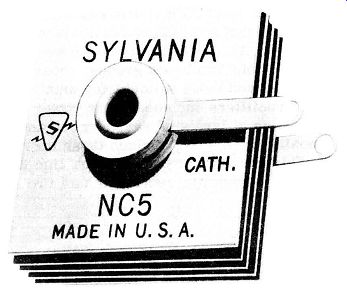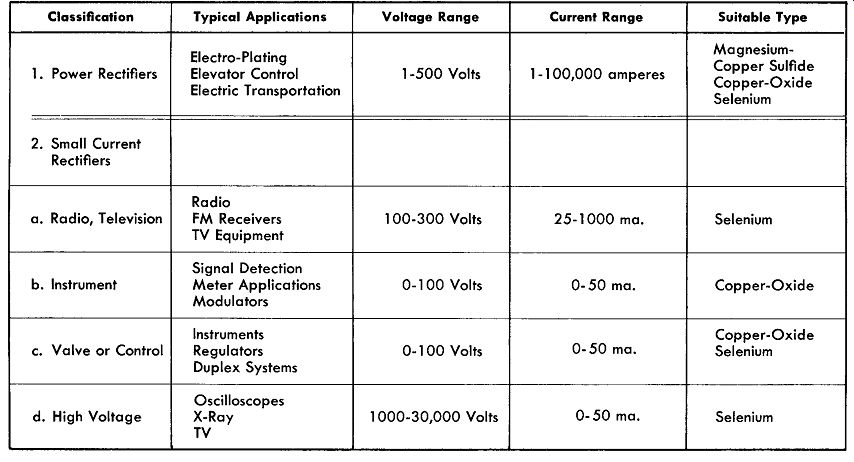AMAZON multi-meters discounts AMAZON oscilloscope discounts
Introduction
Metallic rectifiers are used in many diverse applications; that is, a huge installation may supply 100,000 ampere at 50 volts for an electro-plating process, while in the other extreme a small rectifier, easily inserted into a thimble, converts a DC meter into an AC indicating meter and operates in the milliwatt range at a few volts and milliamperes.
It becomes evident that no one company can specialize is all types of rectifiers suitable to bridge this wide gap.
Moreover, most organizations usually manufacture but one type of rectifier (that is, the selenium, the copper-oxide, or the magnesium-copper sulfide) although a few manufacture two out of the three types of rectifiers.
The application field for metallic rectifiers has become so complex and broad that some classification of metallic rectifiers is necessary. As a preliminary step we might divide metallic rectifiers into two broad groups: those suitable for power rectification, and those suitable for small current applications. The rectifiers included in the power class comprise those operating at levels of, say, over one ampere, while those in the small current group include those operating under one ampere. This one ampere demarcation line is arbitrary but it does separate metallic rectifiers into two convenient groups.
Power Rectifiers
The rectifiers in the first or power group may utilize any one of the three rectifier types discussed, namely, copper oxide, selenium, or magnesium-copper sulfide. When the required rectified output voltage is low and the current requirement great, the chances are that the magnesium-copper sulfide rectifier type will do the job best. When the required rectified output voltage is greater than 50 to 60 volts and the current requirements are moderate to moderately heavy, the better efficiency of the selenium type nominates this type of rectifier for the job. For heavy current control or signaling applications, for example, in railway or elevator work, the reliability and stability of the copper-oxide type recommends it for the job.
Small Current Rectifiers
Rectifiers under the small current classification in themselves cover so broad a field of application that further division of this group is necessary. This may be done as follows:
a. Radio and television rectifiers.
b. Instrument rectifiers.
c. Valve or control rectifiers.
d. High voltage rectifiers.

Fig. 8-1. A Small Current, Half-Wave, Selenium Rectifier Rated at 130 Volts
rms, 100ma, DC. (Courtesy of Sylvania Electric Products, Inc.)
Radio and Television Rectifiers
This group includes small-current rectifiers, usually, of the half-wave type which are specifically designed and in-tended for use in radio and television receiver applications.
The bulk of these rectifiers are of the selenium type, principally due to the higher voltage requirements, and the current ratings of the rectifier stacks cover the range of approximately 25 to 1000 milliamperes. Fig. 8-1 gives a photographic view of a selenium, half-wave rectifier for this application. This half-wave rectifier is rated at 130 volts rms maximum input and will deliver a rectified current of 100 milliamperes DC. In later sections of this guide we shall learn how to use such rectifiers.
----------

Classification
1. Power Rectifiers
2. Small Current Rectifiers
a. Radio, Television
b. Instrument
c. Valve or Control
d. High Voltage
CLASSIFICATION CHART OF METALLIC RECTIFIERS
Typical Applications Voltage Range Current Range Suitable Type Electro-Plating Magnesium Elevator Control 1-500 Volts 1-100,000 amperes Copper Sulfide Electric Transportation Copper-Oxide Selenium Radio FM Receivers 100-300 Volts 25-1000 ma. Selenium TV Equipment Signal Detection Meter Applications 0-100 Volts 0-50 ma. Copper-Oxide Modulators Instruments Copper-Oxide Regulators 0-100 Volts 0-50 ma. Selenium Duplex Systems Oscilloscopes X-Ray 1000-30,000 Volts 0-50 ma. Selenium TV
---------------
Instrument Rectifiers
This group of small-current rectifiers is characterized by stability, wide frequency range, and a current range from 500 microamperes to about 50 milliamperes. Up to the present day the most successful of the metallic rectifiers to fit this application has been the copper-oxide type. Its stability, re producibility, and zero threshold voltage have earned it a place for this job.
Valve or Control Rectifiers
The third group in the small-current rectifier listing includes valve or control rectifiers. The properties most valuable for these applications usually are the non-linear characteristics of the volt-ampere curve, the threshold voltage characteristic, or the "one-way" valve action. In this type of usage both the selenium and the copper-oxide types of rectifiers are useful. Although the magnesium-copper sulfide type of rectifier has a pronounced threshold voltage, its non-reproducibility and severe leakage current usually preclude it from valve or control applications.
High-Voltage Rectifiers
The last group of small-current rectifiers listed in the foregoing is high-voltage rectifiers. The principal need for this type is for rectified output voltages of the order of 1000 to 30,000 volts DC at current levels of a few milliamperes.
Such ratings are typical requirements for cathode-ray instruments, x-ray equipment, television receivers, and the like.
The most suitable rectifier type for this application is the selenium.
The Classification Chart
Summarizing the material in this section, the metallic rectifiers under discussion can be classified as shown in the chart.